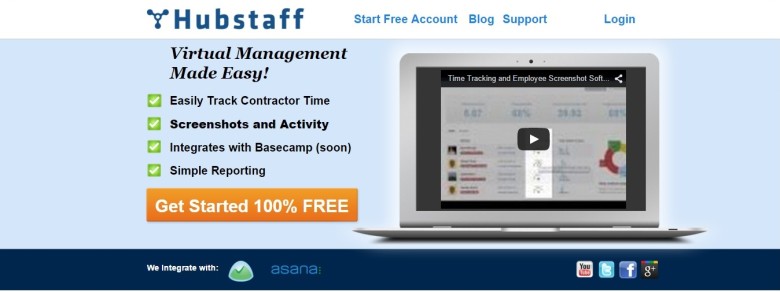Our biggest challenge when launching the beta version of Hubstaff in 2013 was acquiring early adopters. At that point in time, our biggest priority was getting people to use it and give us feedback on improvements. Since we weren’t focused on making money more than ensuring a seamless product, Hubstaff was free at the time. However, acquiring early users proved to be tough, especially since some companies made it look so easy.
Front, which works with shared inboxes for teams, has an awesome SlideShare presentation on how it got its first 2,000 beta signups. Our favorite part is where they mention getting 200 signups from “family, friends, and fools,” because we couldn’t name one family member or friend who would have been interested in Hubstaff. It wasn’t that our product was bad. It’s just hard to pitch something that’s B2B (B2C is much easier) to friends and family.
Finding 25 people to download the beta version of Hubstaff took a lot of work. Here’s how we did it, the things we tried, what worked well and what didn’t.
Boost your team’s efficiency with Hubstaff's productivity tools
What Worked: Inbound Marketing
The first thing we did was set up a landing page using Unbounce. Unbounce is a great tool that lets you quickly and easily build awesome responsive landing pages even if you aren’t tech-savvy. Our page was sleek and Spartan. It prompted you to sign up for free and provided details about time tracking with screenshots.
Here’s what it looked like:
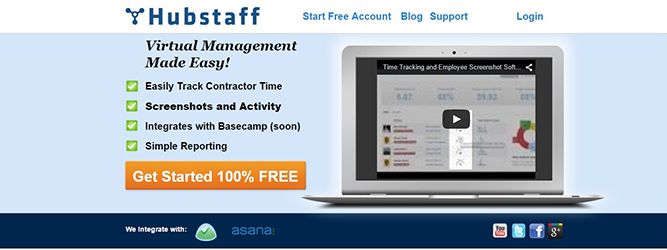
After we put up our landing page, we launched the Hubstaff Blog using WordPress, which is both easy-to-use and highly customizable. We love WordPress for it’s intuitive user interface and extensive functionality, and we’ve written a bunch of posts about it on the Hubstaff Blog.
Starting a blog takes a lot of hard work. You need to dedicate either time (writing the posts yourself) or money (hiring writers). These are two things you likely don’t have when you’re just starting out, especially if you’re in a niche industry offering a free product like we were. Launching a blog and keeping it updated is not easy, but we saw several benefits in it:

- We got to talk to our users: When we first launched, our blog was used in part to let people know about our progress. We also used it to post guides about Hubstaff. A blog is a better option than a newsletter for new companies because it takes a passive approach wherein users come to you, instead of an aggressive one wherein you solicit email addresses for sign ups.
- We got to be social: Everyone knows social media is important, but many young companies don’t have that much to say, and as a result building an audience and driving interest is tough. Our blog gave us stuff to share on social media and allowed us to communicate with potential users and complementary companies.
- We earned traffic and recognition: We optimized our blog and continue to produce content that is relevant and useful to our target audience. Our articles attract intelligent, driven, potential-Hubstaff-users to our blog and eventually, we hope, to try our product. Our blogs rank well on searches that are relevant to our product, which helps to drive valuable traffic to our site.
All our blog posts were keyword-based. We wrote about stuff related to remote teams, such as time tracking, screenshots, and outsourcing. These blog posts led people to us, and the word-of-mouth they generated really helped us grow. Whether it was our landing page or blog, we put a great deal of effort and attention into SEO tools, as we needed people to be able to find us on Google.
The SEO Tools We Used
Before we get into the tools we used, just remember that all the SEO fine-tuning in the world is useless if your content is complete crap. Google’s Panda algorithm and subsequent updates ensures that good content ranks highest, so don’t just stuff your posts full of keywords and expect great results.
All the SEO fine-tuning in the world is useless if your content is complete crap. Share on X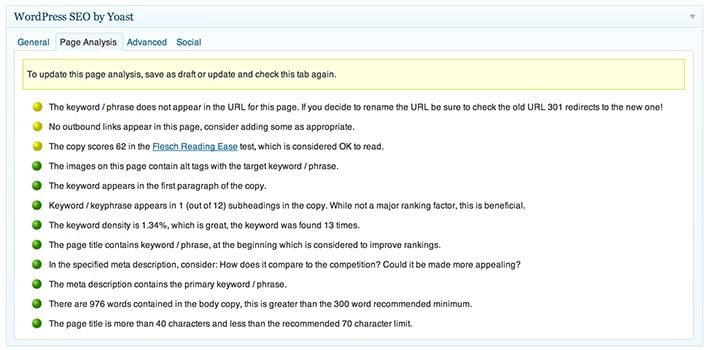
Moving to SEO, we used WordPress SEO by Yoast, a free plug-in that analyzes the SEO of each post in real-time. This information allowed us to make strategic tweaks and ensure that everything we pushed was as search engine-friendly as possible.
Here are the SEO tools we used:
- Moz: Moz offers a ton of tools to make inbound marketing easier, including keyword research, page analysis, and link building opportunities. Moz also has premium plans, but young companies struggling to acquire early users (as we were) can still get a lot from its free plan.
- SEMrush: When you’re the new kid on the block, it helps to research best practices. SEMrush let’s you see what your competitors are up to, including the estimated price they spend in Google AdWords and the keywords used in those ads. This data let us know what keywords we should use and which ones were already being monopolized.
- Ahrefs: Like Moz, Ahrefs offers a bunch of awesome tools that can tighten up your SEO. You can see what sites have linked to your content or site, get tips to fix content so that it ranks higher in Google searches, and even see top content by keyword. That last feature, called Content Explorer, is especially useful since it allows you to find and learn from posts that have gone viral.
- Google Webmaster Tools: Your goal is to get your blog to rank high on Google, so you should be taking its suggestions. Webmaster Tools ensures your pages show up with associated search queries, which is especially useful when crafting a landing page.
A lot of the tools listed above offer either free versions or free trials, so be sure to check them out even if you are on a tight budget. SEO may be new to you, but it’s worth taking the time to research and learn about it. We found that outbound marketing didn’t work (more on that below), so we needed people to find us. We couldn’t have done that without a working knowledge of SEO.
Oh, and paid ads also helped.
What Worked: Paid Ads
We primarily ran campaigns through Google AdWords with a budget of $2,000/month. Our ads ran internationally, as we were speaking to a global market. Google AdWords was an invaluable resource in driving traffic to our landing page and blog. Our SEO tools helped us find the keywords we should be targeting, but we didn’t really have any set goals in mind. While word of mouth was huge for us, ads really helped to drive traffic to Hubstaff in the beginning, traffic which occasionally converted to new users.
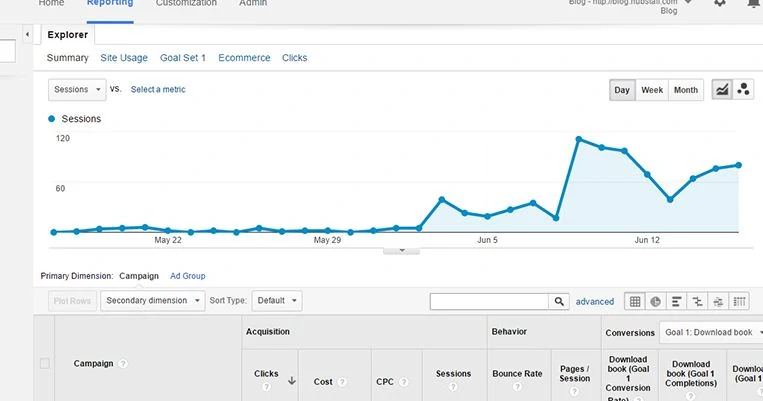
What Worked: Product
As mentioned earlier, Hubstaff beta was offered as a free download. Here’s what the pitch to our first users looked like:
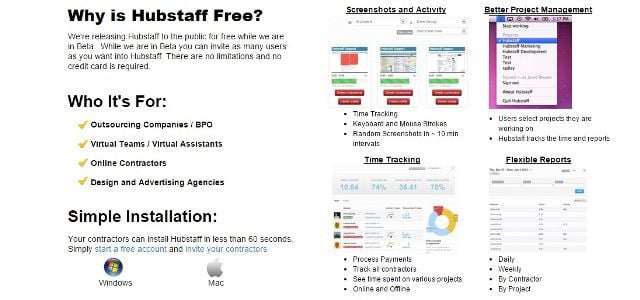
We knew that there were still bugs that needed to be squashed before we could even think about offering a paid version. It was tough getting 25 people to download and use Hubstaff for free, but things would have been much tougher if we had put a price tag on an unfinished product. When it comes to desktop-based software you really need feedback from users on multiple operating systems and machines to regarding bugs.
A free product will help you get that.
In addition to offering Hubstaff for free, we also made sure that we were in as niche a market as possible. If we were strictly involved in time tracking we would have never been able to get traction in the early stages. Since we concentrated on time tracking for remote teams and workers, it was a little easier to find users. If you think your product may be too broad or your market too crowded, try to narrow your focus down further.
Learn how to analyze model, market and concept at Test your startup idea: A list that took me 8 years to develop.
What Worked: People
Reaching out to people worked–to an extent. We didn’t just comment on any and every blog we could find, though. Instead, we searched Google for the keywords we wanted to rank for and then visited the blogs we found. After reading the posts we would leave an insightful comment as well as a link to our blog.
This helped us engage people in our industry and was another easy and organic way to spread the word about Hubstaff. Additionally, we were also listed on the software directories Brothersoft and App Appeal, which also got us some recognition. While commenting on blogs and getting listed didn’t lead to as many users as inbound marketing, it still helped spread the word about what we were doing to relevant audiences. It was still valuable, because when you’re talking about acquiring 25 users for a brand new product, you need all the help and link backs you can get.
What Helped: The Traction Book
The story of how we acquired our first 25 users can’t be told without a quick mention of “Traction: A Startup Guide to Getting Customers.” This book, by Gabriel Weinberg and Justin Mares, was an invaluable resource to us when we were just starting out.
All of the above helped us get our first 25 users, but it wasn’t all a string of small and large successes. In fact, we tried and failed in many other ways to get people to try out the beta version of Hubstaff.
What Didn’t Work: Reaching Out Online
We filled out a ton of contact forms on websites and sent numerous emails to companies and and individuals who worked with remote teams and the results were always the same: We got no responses.
We even reached out to people via Craigslist. We would contact people who posted ads seeking remote workers. The logic was sound: You need remote workers and Hubstaff is built to manage remote teams, so why not check it out? Although it sounded like a great idea, we never heard anything back from those people either.
A variety of factors likely contributed to our online outreach failing.
It’s highly possible that our messages were filtered or trashed upon arrival. Who really takes the time to read a cold email from a company they’ve never heard of? Remember too that we were working with niche software in a small industry, so even if someone did read our email they may not have even had a need for Hubstaff. At the end of the day, writing emails and filling out contact forms took too long and provided nothing in return, so we quickly abandoned the tactic. That’s not to say that reaching out to people in the real world worked any better.
What Didn’t Work: Pitching to Groups In-Person
No, my co-founder and I did not go door to door talking to people about Hubstaff.
What we did do was visit startup events in our area to meet fellow entrepreneurs and techies to share what we had built. We attended a Lean Startup Circle event in Indianapolis. On paper this seemed like the perfect place to go to present Hubstaff, gather feedback, and potentially pick up new users. However, this Meetup group proved fruitless in terms of generating interest and new users. In fact, many people there never even knew this type of software existed! Here’s a Twitpic from our presentation:
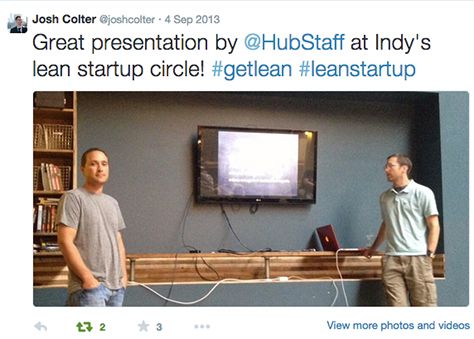
We also attended the Innovation Showcase in Indianapolis. Whereas Lean Startup Circle focused on individuals and small startups, the Innovation Showcase was a place for companies to network with one another and meet potential investors. Despite a larger and more diverse audience, we still encountered the same problem as when we attended the Meetup group. Either people had never heard of this type of software or they weren’t interested enough to give it a spin. Still, we got up on the stage and gave it a go:

So family and friends were out, but what about other entrepreneurs? Certainly they’d be up to try out some awesome new software. As it turns out, the entrepreneurs I met as a member of EO (Entrepreneurs’ Organization) and YEC (Young Entrepreneur Council) didn’t really know what to make of Hubstaff.
It’s not that these men and women didn’t know their stuff. EO has more than 10,000 members, and the invite-only YEC targets successful entrepreneurs under 40. The issue we encountered was similar to when we brought Hubstaff to our friends and family: They didn’t really have a need for it.
Reaching out in person to acquire early users didn’t work for us because we were in the wrong market. Hubstaff appeals to a very small subsection of people; those who work remotely or manage remote teams. It would have been very tough for us to sell someone on our product if they weren’t already looking for something like it.
What Didn’t Work: Becoming a Thought Leader
Simply put, we didn’t try too hard to become thought leaders. What we were building was pretty niche, even for the already niche world of remote teams. There just didn’t seem to be a point in putting in the time and effort needed to establish ourselves as a thought leader in a small section of a small industry, especially since it wouldn’t help in acquiring early users.
The First 25
As you can see, we put a lot of work into getting just 25 people to sign up for our beta version. There was a lot of trial and error, but once we learned what worked we were able to focus in and refine our efforts. We still rely on word-of-mouth and inbound marketing to grow Hubstaff. That being said, all of the search engine optimization and AdWords purchases are nothing without a great product, and we’re working to make Hubstaff better every day so that we can continue to grow without compromising quality.
All of the search engine optimization and AdWords purchases are nothing without a great product. Share on XIf you want to see how we’ve gone from 25 free users to 1237 paid users, check out the Hubstaff Growth Blog. It’s filled with informative posts that show just how we managed to grow and the strategies we used along the way.
Subscribe to the Hubstaff blog for more growth strategies
Read more about startup growth strategies here.
How did your company acquire early adopters? What tools did you use to do that? Join us in the comments below!
Most popular
The Fundamentals of Employee Goal Setting
Employee goal setting is crucial for reaching broader business goals, but a lot of us struggle to know where to start. American...
Data-Driven Productivity with Hubstaff Insights: Webinar Recap
In our recent webinar, the product team provided a deep overview of the Hubstaff Insights add-on, a powerful productivity measurem...
The Critical Role of Employee Monitoring and Workplace Security
Why do we need employee monitoring and workplace security? Companies had to adapt fast when the world shifted to remote work...
15 Ways to Use AI in the Workforce
Whether through AI-powered project management, strategic planning, or simply automating simple admin work, we’ve seen a dramatic...

